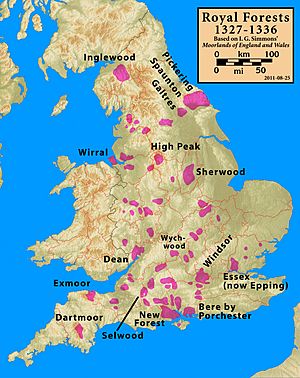Inglewood Forest facts for kids
Inglewood Forest is a large tract of mainly arable and dairy farm land with a few small woodland areas between Carlisle and Penrith in the English non-metropolitan county of Cumbria or ancient county of Cumberland.
Contents
Etymology
Inglewood is first attested in the forms Englewod’ (c. 1150), Engelwode (c. 1158) and Englewud (1227). The name means "Wood of the English or Angles". This seems to reflect a situation where, at the time of the name's formation, Cumbria was still predominantly a Celtic-speaking region, and sometimes part of the Kingdom of Strathclyde, and English settlement or land-ownership was still unusual enough to be a distinctive feature in a place-name. Noting that the other place-names of this kind are in places that were border areas between English-speaking and Britonnic-speaking cultures, Jayne Carroll and John Baker suggest that 'this is perhaps not a case of a "minority population" name, but one used with a particular political significance to mark a borderland area'.
History
Soon after the Norman conquest of England this area became a Royal Forest. The word forest in this sense did not necessarily mean a wooded area but one that was set aside for hunting though several areas of Inglewood were heavily wooded. The animals that were hunted in this area were mainly deer and wild boars.
The forest boundaries changed many times and included at one time most of the Cumberland wards of Leath and Cumberland but the core or heart of the forest was the parishes of Hesket-in-the-Forest, Skelton and Hutton-in-the-Forest. Higham places the "core of the forest between the Chalk Beck and the River Petteril, in particular the townships and civil parishes of Dalston, Sebergham, Hesket, Mungrisdale, Catterlen, Hutton, Skelton, and Castle Sowerby".
The forest ultimately belonged to the English Crown and was governed by the strict Forest Law exercised by wardens. In the reign of Henry VIII the forest laws were repealed and Inglewood ceased to be a Royal Forest although it is still to this day marked on maps as such".
The borough and city of Carlisle (the area within the city walls) was outside the forest though Penrith was within it and was the main administrative centre and market town for the southern part of the region.
Border reivers were active in the area and it contains a number of fortified buildings referred to as Peel towers.
| Grid reference | Name | Location | NHLE | Sources for "peel"/"pele" |
|---|---|---|---|---|
| NY505458 | Armathwaite Castle | Armathwaite | 1145496 | Pevsner; Ordnance Survey |
| NY476384 | Brackenburgh Tower | Calthwaite | 1145499 | Pevsner; see Perriam and Robinson |
| NY478320 | Catterlen Hall | Catterlen | 1012829 | Pevsner |
| NY475524 | Cote House | Wetheral | 1111822 | Perriam and Robinson, and also Pevsner, say Bastle house; Ordnance Survey |
| NY376515 | Dalston Hall | Dalston | 1087441 | Ordnance Survey |
| NY551367 | St Cuthbert's Church | Great Salkeld | 1100260 | RIBA |
| NY403433 | High Head Castle | Ivegill | Perriam and Robinson | |
| NY518302 | Hutton Hall | Penrith | 1326922 | NHLE; see Perriam and Robinson |
| NY460357 | Hutton in the Forest | near Skelton | 1210817 | Pevsner |
| NY433509 | Newbiggin Hall | St Cuthbert Without | 1087720 | Pevsner |
| NY396436 | Thistlewood | Ivegill | 1326687 | Pevsner; see Perriam and Robinson |
| NY433499 | Woodside | St Cuthbert Without | see Perriam and Robinson |
Literature
The Forest is the setting of many of the adventures in the late medieval Northern Gawain Group of Middle English chivalric romances. Around the same time, Andrew of Wyntoun's Orygynale Chronicle (written c. 1420) claims the forest as the original setting of the Robin Hood legend:
- Lytil Jhon and Robyne Hude
- Wayth-men ware commendyd gude
- In Yngil-wode and Barnysdale
- Thai oysyd all this tyme thare trawale.
According to legend, Inglewood Forest is also home to the outlaws Adam Bell, William of Cloudsley and Clym of the Clough; Their story told in Child Ballad 116.
Honour of Penrith
The manors of Penrith, Great Salkeld, Langwathby, Carlatton (not Carleton as it sometimes said to be), Castle Sowerby and Scotby were collectively known as the Honour of Penrith and were at first given to the Scottish crown in exchange for Scotland giving up its claim to all of Cumberland. In 1272 King Alexander III complained that a William de Leyburne, the local seneschal, has unlawfully appropriated the manors' rents. Later Edward I took them for himself. Later they passed to the Neville family but came back to being Crown property during the Wars of the Roses and remained so until the joint reign of William III and Mary II. The honour was also known as "The Queen's Hames" due to the fact the manors were often given to a Queen consort on her marriage or at the death of the previous consort. The last Queen consort to be Lady of the Manor or Honour was Queen Catharine of Braganza, consort of Charles II. Glassonby and Gamblesby were sometimes included in the Honour,
William III gave the lands belonging to the manor to his friend William Bentinck, 1st Earl of Portland whose descendants later sold them to their relatives the Cavendish family.


